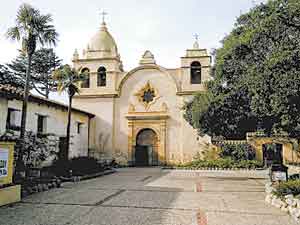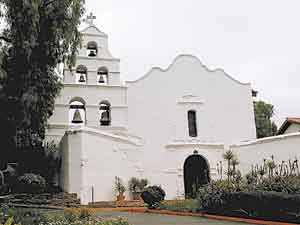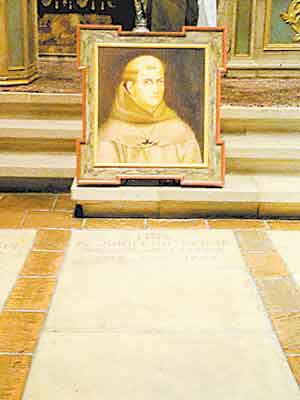 Some years before I was ordained, during a visit to my grandmother in Washington, D.C., I went over to the U.S. Capitol and just roamed around. I recall seeing the statue of a man wearing Franciscan robes holding a church in one hand and a cross in the other. The base was engraved with the name “Serra.” At the time, I didn’t know anything about the man the statue portrayed. I have since learned that it represented Father Junípero Serra, a Franciscan priest from Spain who is considered the builder of the state of California and one of four Catholic priests honored in the U.S. Statuary Hall. Ever since then, I have been interested in the missions of California.
Some years before I was ordained, during a visit to my grandmother in Washington, D.C., I went over to the U.S. Capitol and just roamed around. I recall seeing the statue of a man wearing Franciscan robes holding a church in one hand and a cross in the other. The base was engraved with the name “Serra.” At the time, I didn’t know anything about the man the statue portrayed. I have since learned that it represented Father Junípero Serra, a Franciscan priest from Spain who is considered the builder of the state of California and one of four Catholic priests honored in the U.S. Statuary Hall. Ever since then, I have been interested in the missions of California.
I recently returned from a pilgrimage to the 21 old missions of California that were founded by the Franciscans from 1769 to 1823. It was a spiritual journey along El Camino Real (“the Royal Highway”), and I learned a lot of history while being inspired by the missionary zeal of the Franciscans.
Our Lord gave His apostles the commission to: “Go forth and make disciples of all nations!” (see Mt 28:19) With the colonization of the New World, missionaries sought to bring the joy of the Gospel to the natives living on this continent. Father Serra was one of these missionaries, arriving in Mexico from Spain and then being sent to California where he established the first mission of San Diego. He would go on to establish eight more mission before his death in 1784.
At Father Serra’s beatification ceremony in 1988, St. John Paul II said that the priest was “a shining example of Christian virtue and the missionary spirit.”
Father Serra learned the languages of seven different tribes and prepared a catechism for each. He also worked with the natives and helped them to develop farming techniques and basket making skills, as well as the manufacture of leather products (such as saddles) and other items that could be used in trade. The Franciscans planted the first grapes and oranges in California and also opened the first school.
The major cities of California had humble beginnings as Franciscan missions. For example, the mission of San Gabriel provided the seed for the modern city of Los Angeles, which is today the second largest city in the nation.
There were times when the good padres stood between the natives and the Spanish soldiers stationed in the area to protect the missions but who did not always practice the virtues.
The Franciscans did not believe in forced conversions but always sought to live in accord with Gospel values to teach the faith. There were thousands of baptisms during the mission period.


 Pictured are San Diego, the first mission of 1769; San Carlos in Carmel; and San Junípero’s grave in the sanctuary of San Carlos, Carmel. The saint died in the Mission of San Carlos in 1784. (Photos provided by Father Mark Lawlor)Today, there are some 10 million Catholics in California, and their faith is rooted in these early missions.
Pictured are San Diego, the first mission of 1769; San Carlos in Carmel; and San Junípero’s grave in the sanctuary of San Carlos, Carmel. The saint died in the Mission of San Carlos in 1784. (Photos provided by Father Mark Lawlor)Today, there are some 10 million Catholics in California, and their faith is rooted in these early missions.
The missions began under the jurisdiction of Spain, but after Mexico gained independence from the Spanish crown in 1721, they fell under Mexican rule. The Franciscans were dismissed by the authorities of Mexico in 1734 during a time of secularization. During the war between the U.S. and Mexico in the 1840s, some of the missions were actually occupied by U.S. forces. Some missions fell into disrepair or suffered from earthquakes or fires.
After California became a state in 1850, most of the missions were returned to the Catholic Church by U.S. presidents, including Abraham Lincoln shortly before his assassination.
Today, 19 of the original missions are still connected with or are serving as parishes. Two are part of the California State Park system. Several have Catholics schools connected with them and the old Mission of Santa Clara sits in the middle of the campus of Santa Clara University.
The missions still serve the Church, as this pilgrim can attest. At the Mission of San Raphael, for example, Mass is celebrated in five languages every Sunday: English, Spanish, Portuguese, Vietnamese and Haitian!
I returned to Charlotte from my pilgrimage inspired by the early missionaries. I am reminded that our faith is built on those who blazed the mission trail before us. At the canonization of Blessed Junípero during his pastoral visit to the United States in 2015, Pope Francis said the following:
“Father Junípero Serra was the embodiment of ‘a Church which goes forth.’ He was excited about blazing trails, going forth to meet many people, learning and valuing their particular customs and ways of life. He learned how to bring to birth and nurture God’s life in the faces of everyone he met; he made them his brothers and sisters. Junípero sought to defend the dignity of the native community, to protect it from those who had mistreated and abused it. Father Serra had a motto which inspired his life and work, a saying he lived his life by: ‘¡siempre adelante!’ (‘Keep moving forward!’) For him, this was the way to continue experiencing the joy of the Gospel. ... He kept moving forward, because the Lord was waiting. He kept going, because his brothers and sisters were waiting. He kept going forward to the end of his life. Today, like him, may we be able to say: Forward! Let’s keep moving forward!”
Father Mark S. Lawlor is the pastor of St. Vincent de Paul Church in Charlotte.


